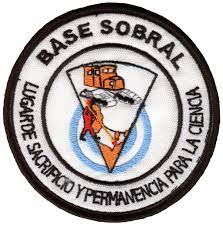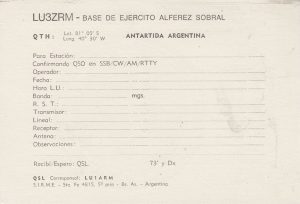 Sobral Scientific Base ( Base Base Científica Sobral or Base Sobral) was a permanent, all year-round and now only partially active Argentine Antarctic base and scientific Research Station located on the Filchner Ice Shelf at 81°04′05″South, 40°36′01″West. It bears its name in honor of the late 19th and early 20th century Argentine explorer Ensign José María Sobral, who had joined Dr. Otto Nordenskjöld’s ill-fated Swedish Antarctic expedition in 1903. Josè Maria Sobral was the first Argentine known to winter in Antarctica.
Sobral Scientific Base ( Base Base Científica Sobral or Base Sobral) was a permanent, all year-round and now only partially active Argentine Antarctic base and scientific Research Station located on the Filchner Ice Shelf at 81°04′05″South, 40°36′01″West. It bears its name in honor of the late 19th and early 20th century Argentine explorer Ensign José María Sobral, who had joined Dr. Otto Nordenskjöld’s ill-fated Swedish Antarctic expedition in 1903. Josè Maria Sobral was the first Argentine known to winter in Antarctica.
The initial purpose of the Bse was to serve as a stopover on the route of the Argentine expedition to the South Pole, which was reached on December 10, 1965 in the so-called Operation 90.
 Sobral Base (WAP ARG-Ø3) was founded on April 2, 1965 by a crew of 5 men from the Belgrano I Base (WAP ARG-Ø5) who sent a message to Buenos Aires the following day urging them to speed up the departure of the polar expedition by the first days of October, given the ice instability. Thus, on October 26, 1965, a group of 10 men left the Belgrano I Base and a few days later arrived at Sobral Base, reaching the South Pole on December 10, 1965.
Sobral Base (WAP ARG-Ø3) was founded on April 2, 1965 by a crew of 5 men from the Belgrano I Base (WAP ARG-Ø5) who sent a message to Buenos Aires the following day urging them to speed up the departure of the polar expedition by the first days of October, given the ice instability. Thus, on October 26, 1965, a group of 10 men left the Belgrano I Base and a few days later arrived at Sobral Base, reaching the South Pole on December 10, 1965.
Sobral Base (420 km south of Belgrano base and 780 km north of the South Pole), could accommodate a maximum of 7 people. Because the ice from the barrier caused cracks in the structures, the Base was closed on October 28, 1968 after 3 years of continuous service, and was quickly buried under the ice of the Filchner barrier. In November 1983, a reconnaissance patrol on Ski-Doo motorcycles with tow sleds, made up of six men, set out for the first time from the Belgrano II Base (WAP ARG-Ø6) with the mission of establishing a new route between Belgrano II and Sobral Base. They managed to locate the objective and reactivate it after 15 years, carrying out maintenance, communications, meteorological measurements and topographic reconnaissance tasks up to the Diamante mountain range, in places not visited by man.  After 23 days of exploration, using nine days to go and four to return, they successfully returned to the Belgrano II leaving written testimonies in plastic tubes and marking the path with reeds and banners. After 14 years of this last reactivation, it was not possible to find it in 1997 when a patrol of 4 men from Belgrano II Base went in search of it. That patrol identified the place where the base should be located and established fuel depots for future operations in the region.
After 23 days of exploration, using nine days to go and four to return, they successfully returned to the Belgrano II leaving written testimonies in plastic tubes and marking the path with reeds and banners. After 14 years of this last reactivation, it was not possible to find it in 1997 when a patrol of 4 men from Belgrano II Base went in search of it. That patrol identified the place where the base should be located and established fuel depots for future operations in the region.
On December 13, 1999, a 7 man expedition that repeated the route to the South Pole arrived at the place indicated by the 1997 patrol, finding the remains of stakes and the Argentine flag, as well as fuel drums. The expedition searched for Sobral Base, finding it 11.5 km from its original position, finding the 3-meter-high antenna towers that protruded about 30 cm from the ice. The expedition members excavated the ice and managed to enter the base, staying there for two days.
 On 10 October 2000 a six-men research expedition established a scientific camp at Sobral’s emplacement and measured local ozone levels with a spectrophotometer. The temporary occupation was conducted by personnel belonging to Belgrano II and a technician from the National Antarctic Directorate; since then, a new expedition is sent every year between September and December, where the lowest annual average concentration of ozone in Antarctica is recorded.
On 10 October 2000 a six-men research expedition established a scientific camp at Sobral’s emplacement and measured local ozone levels with a spectrophotometer. The temporary occupation was conducted by personnel belonging to Belgrano II and a technician from the National Antarctic Directorate; since then, a new expedition is sent every year between September and December, where the lowest annual average concentration of ozone in Antarctica is recorded.
In order to reach the remote base this team must travel for distances up to 400 km (250 mi) over very rugged ice terrain filled with numerous cracks, which pose an often unpredictable threat. Snowcat heavy  vehicles are used to cover half of the route; light vehicles like the Yamaha VK-540 II Ski-Doo are preferred for the rest. The party carries all the necessary equipment for a three-months stay, such as tents, fuel, supplies, survival kits, communication hardware and scientific instruments.
vehicles are used to cover half of the route; light vehicles like the Yamaha VK-540 II Ski-Doo are preferred for the rest. The party carries all the necessary equipment for a three-months stay, such as tents, fuel, supplies, survival kits, communication hardware and scientific instruments.
Sobral Base WAP ARG-Ø3, remains one of the most rare sites with very few Hamradio operations. 3 are the callsigns used from Base Sobral: LU1ZZ LU2ZZ and LU3ZRM.
.
TNX Olivier F6EPN (Spratley Woody) for the help in finding old QSL
